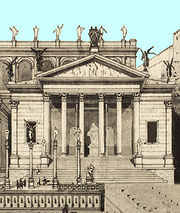Aedes Concordiae
Home | Latíné | Deutsch | Español | Français | Italiano | Magyar | Português | Română | Русский | English
⚜⚜⚜ Site Index - Key Pages ⚜⚜⚜
Concordia had several temples at Rome. The principle one is located at the west end of the Forum Romanum. Tradition says it was built as early as the time of Camillus (367 BCE), who vowed and built it in commemoration of the reconciliation between the patricians and plebeians.[1][2] Archaeological evidence shows that the first building on this site dates to 121 BCE, when a temple was built by L. Opimius. Prior to that, the site seems to have held only an altar.[3] This temple, in which meetings of the senate were often held[4] , but which appears to have fallen into decay, was restored by Livia, the wife of Augustus, and consecrated by Tiberius (A.D. 10), after his victory over the Pannonians. This is commemorated on a sestertius minted in 35 or 36.[5] [6] In the reign of Constantine and Maxentius, the temple was burnt down, but was again restored.
On the final destruction of this building in the early 15th century CE, Lanciani (p. 53) quotes Poggio Bracciolini (1380 – 1459), "I saw the Temple of Concord almost intact (ædem fere integram), built of white marble. Since then the Romans have demolished it, and turned the structure into a lime-kiln."[7] A piece of entablature and a column capital from the cella survived the destruction and are now preserved in the Palazzo dei Conservatori.
A second temple of Concordia was built by Cn. Flavius on the area of the temple of Vulcanus.
A third was vowed by L. Manlius during a seditious commotion among his troops in Gaul, and was afterwards erected on the Capitoline hill.
Other temples were frequently built to commemorate the restoration of civil harmony.
External Links
- UCLA's Digital Roman Forum: Concordia, Aedes
- Visible Past: Aedes Concordiae
References
- ↑ Ovid, Fasti: I, 637-650
- ↑ Plutarch, Camillus: 42.3
- ↑ vide UCLA Digital Forum
- ↑ Cicero, In Catalinam III: 20
- ↑ Examples of this sestertius: image and description, image only
- ↑ Date of CE 35 or 36 based on reverse legend: "CAESAR DIVI AVG F AVGVST P M TR POT XXVII"
- ↑ Lanciani, R. (1893). Pagan and Christian Rome
